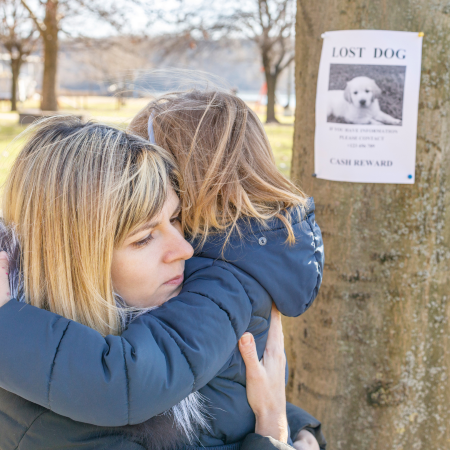The most dreaded feeling a pet owner can experience is realizing that they can’t find their pet. It happens to thousands of people every year and the feeling of helplessness can be overwhelming. There are, however, steps you can take to increase your chances of being reunited with your pet should this happen to you. With perseverance, marketing, your personal friend network and a little luck you can create an environment that is conducive to quickly recovering your family friend.
Plan Ahead
There are some things you can do before your pet goes missing that will assist you in your recovery efforts. Making sure your pet has ID tags with current address and telephone information is by far the best thing you can do. If your pet has an implanted microchip make sure the information on file for you is updated.
Quick access to a photo of your pet can help if you have to make flyers or hit the streets. If you introduce your pet to other pet owners in the neighborhood not only will your pet be better socialized, but your neighbors will easily recognize your pet if they spot it from a distance.
Take a Deep Breath
The first step is to remain calm! Running around without a clear plan will only frustrate your family or friends and get you no closer to finding your pet. Begin a systematic search of your pet’s favorite hiding places within the house such as closets, under the couch, or under the bed.
You can try to entice your pet out of its hiding spot by shaking a food bowl, car keys or anything your pet will respond to. If you have no luck inside the house you can extend your search outside and start looking underneath decks, bushes or any other hiding place that your pet may find comfortable. House pets, especially cats that don’t get out much, may not venture far and stay close to home.
Get Going
The next step is to hit the streets and mobilize your network of family and friends. If your pet has only been missing for a short period of time, going out on foot is the best method as opposed to a vehicle. You’re more likely to spot your pet at the slower pace and your pet is more likely to come to you if you’re on foot. Make sure you’ve got a current picture of your pet and start to talk to your neighbors.

Get as many people as you can walking and talking on your behalf. If you don’t see your pet the first time you walk down a street don’t despair, keep looking. Canvas the neighborhood several times a day. If your pet is lost it may be scared and hiding. Don’t give up; perseverance is the key.
Make the Call
After you’ve thoroughly checked the neighborhood it’s time to get on the phone. There are many agencies you need to call to make sure you have all your bases covered. You can also use the internet to your advantage by searching maps and finding shelters close to home.

Find out which shelters (including private ones) are in your area and place calls to them. Describe your pet in detail: sex, breed, size, weight, name, distinguishing features and any medical issues they may have. Visit the shelter yourself at least every other day. Even with ID tags your pet may be overlooked as the person working the phones may not be the person interacting with the animals.
Contact any animal rescues in the area that may have picked up your pet from the shelter. Many rescues are breed specific and will rescue that breed from shelters, especially if the shelter euthanizes animals. Shelters will be able to tell you which rescues operated in the area. You can also call the police department and give them the same information you gave to the shelter; it will also help to stop by the department in person. Unfortunately, some pets get hit by vehicles and are picked up by highway maintenance personnel. While they may or may not report information to the shelters, it’s a good idea to contact them with the same information.
Start Your Marketing Campaign
Once you’ve made all your phone calls start a marketing campaign around the neighborhood using various media. Depending on the size of your community, consider calling the local radio stations and ask them to put the word out. Local television stations may have some time devoted to lost pets on the nightly or morning news. Again, use the internet to your advantage and find any local sites where you can post your notice.
The most effective method, which is the most visible, is flyers. Have a plan when you post flyers and make sure you always ask permission when posting on private property. Brightly colored flyers with a bold headline will grab the most attention. Post anywhere people from your neighborhood are likely to frequent: gas stations, grocery stores, pet stores and restaurants.

Schools are a good place as children spend more time outdoors and are more likely to see a pet running around the neighborhood. Put some flyers by the food section of the pet store; if people are holding on to the pet they’ll have to get supplies at some point. Lastly, leave flyers when you visit the agencies that may be holding your pet. The flyer, coupled with your visits, will ensure they don’t forget who you or your pet are.
Beware the Scams
Unfortunately, there are unsavory individuals who like to take advantage of people who are in trouble. Beware of any pet recovery scam artists that may try to take advantage of your situation. If someone contacts you and offers to return your pet in exchange for wiring them money (to cover the costs of food or perhaps a vet visit) should be regarded with caution. If they cannot describe your pet beyond what is on the flyer, steer clear.
Keep the Faith
The loss of a pet may seem like a dire situation, but a plan that is carried out efficiently will help speed up the process. You have to keep visiting the shelters, keep asking around the neighborhoods and keep posting flyers. There are pets out there that have been reunited with their owners months after they went missing. Don’t give up and your pet will thank you!
[Editor’s Note: When indoor cats go missing they’re typically within 100-feet of the home. They don’t go far. They are hiding, however, because they’re frightened. If you can, leave a way for them to get back in, such as a slightly raised garage door. Then, around 3am when things calm down, they are likely to return home. This has been our experience with two separate cats. If you’ve lost your pet, we wish you the best of luck in recovering them soon!]
Copyright 2013, PetHub, Inc. All rights reserved.


